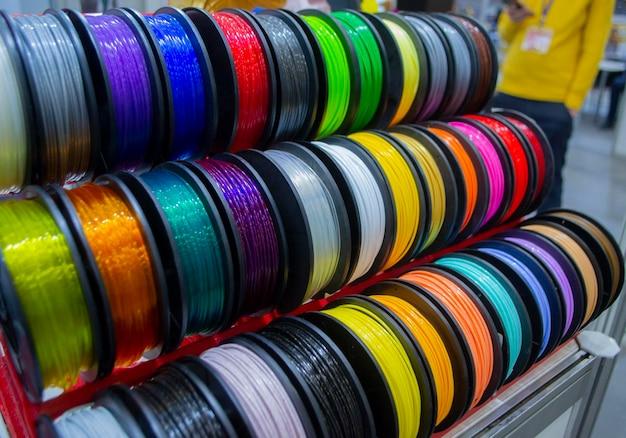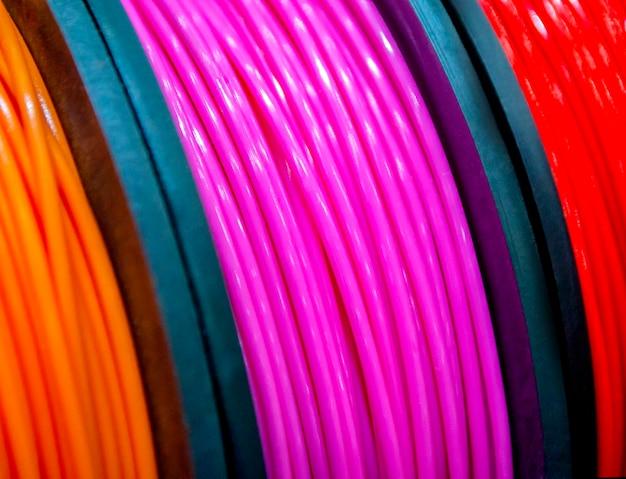In recent years, 3D printing has become a popular method for creating unique and personalized objects, including kitchen utensils and accessories. But when it comes to using 3D printed items in direct contact with food, there are some important considerations to keep in mind. In this blog post, we will explore the different types of 3D printer filaments and their safety for use with food.
From PLA to PETG, TPU to polycarbonate, we will delve into the characteristics of each filament and whether they are food safe. We’ll answer common questions such as whether 3D printed cookie cutters need to be food safe, if they can be washed in the dishwasher, and if you can safely drink from a 3D printed cup. So, if you’re curious about the safety of 3D printer filaments for food-related applications, read on to learn more!
What 3D Printer Filaments Are Food Safe
Imagine this scenario: you’ve just finished printing a stunning 3D model of a delectable pizza, and you can’t wait to take a bite. But hold on a second! Before you sink your teeth into that printed masterpiece, it’s crucial to consider the safety of the filament used in your 3D printer. After all, you wouldn’t want to devour something that could potentially harm your health. So, let’s explore the world of food-safe 3D printer filaments and find out which ones are the best fit for your culinary creations.
PLA: Polylactic Acid, the King of Food-Safe Filaments
If you’re searching for a food-safe 3D printer filament, look no further than PLA (polylactic acid). PLA is a widely popular option due to its biodegradability, non-toxic nature, and its ability to be derived from renewable resources such as corn and sugarcane. The fact that PLA is also used in numerous food packaging applications further emphasizes its safety when it comes to contact with edibles. So go ahead and use PLA to whip up some delicious cookie cutters or kitchen utensils – your taste buds and Mother Nature will thank you.
PETG: The Versatile and Food-Safe Filament
PETG (polyethylene terephthalate glycol-modified) is another excellent choice for food-safe 3D printing. Combining the best properties of both PLA and ABS (acrylonitrile butadiene styrene), PETG offers high strength, flexibility, and temperature resistance. This filament is approved by the Food and Drug Administration (FDA) for food contact, making it a reliable option for creating custom-made food containers, utensils, or even components for kitchen appliances. PETG is your reliable companion when you want sturdy prints that won’t leach harmful substances into your culinary creations.
TPU: Tasty Prints with Thermoplastic Polyurethane
When it comes to creating food-related objects that require flexibility and durability, TPU (thermoplastic polyurethane) takes the cake – or rather, the pasta! This elastic filament can withstand repeated use and bending, making it ideal for printing custom pasta makers, kitchen gadget grips, or even dessert molds. Though not explicitly FDA approved, TPU is generally considered safe for food contact, especially if the printed items are washed thoroughly before use. So if you’re thinking of adding a touch of elasticity to your culinary endeavors, TPU is the filament for you.
Other Considerations for Food-Safe 3D Printing
While PLA, PETG, and TPU are popular choices for food-safe 3D printing, it’s crucial to consider some additional factors. First, always ensure that your 3D printer is properly calibrated and clean to avoid any contamination that could compromise the food safety of your prints. Second, keep in mind that post-printing processes, such as sanding or painting, may introduce non-food-safe elements to your prints. Finally, avoid using filaments with unknown compositions or ones that are known to contain potentially harmful additives.
In conclusion, when it comes to 3D printing food-safe objects, PLA, PETG, and TPU are your go-to filaments. Whether you’re looking for biodegradability, high strength, flexibility, or all of the above, these filaments have got you covered. So, fire up your 3D printer, let your imagination run wild, and create culinary masterpieces that are as safe as they are scrumptious. Happy printing and bon appétit!
Note: The content generated by OpenAI GPT-3 and any responses from the AI are solely for informational purposes and should not be considered as legal, financial, medical, or professional advice.
FAQ: What 3D Printer Filaments Are Food Safe
Welcome to our informative FAQ-style guide on 3D printer filaments and their food safety! Whether you’re a baking enthusiast or simply curious about the safety of using 3D printed objects around food, we’ve got you covered. Prepare to have your burning questions answered in an engaging and humorous manner. Let’s dive right in!
Do Cookie Cutters Need to Be Food Safe
Absolutely! When using cookie cutters for preparing edible treats, it’s crucial to ensure they are made from food-safe materials. To achieve this with 3D printed cookie cutters, it’s essential to choose filaments that are specifically labeled as food safe.
Are 3D Printed Cookie Cutters Dishwasher Safe
While 3D printing allows for endless creativity, not all filaments are suitable for the dishwasher. Many common filaments, such as PLA and PETG, may become warped or damaged when exposed to high heat levels. Therefore, it’s best to hand wash your 3D printed cookie cutters to ensure their longevity.
Is TPE Filament Food Safe
Unfortunately, TPE (Thermoplastic Elastomer) filament is not recommended for direct contact with food due to its potential to harbor bacteria and difficulty in properly cleaning the material. It’s better to explore alternative filaments that are explicitly designated as food safe.
Is PETG Microwave Safe
No, PETG (Polyethylene Terephthalate Glycol) filament is not microwave safe. PETG has a relatively low melting point, making it susceptible to deformation under high temperatures. To avoid any mishaps, it’s advisable to transfer your food to microwave-safe containers before heating.
Is PLA Filament Safe for Food
Yes, PLA (Polylactic Acid) filament is generally recognized as safe (GRAS) by the FDA, making it a popular choice for 3D printing food-related items. However, it’s essential to note that not all PLA filaments are explicitly food safe. Look for filaments labeled as “food safe” or “FDA approved” to ensure you’re using the right material.
Is 3D Printer Filament Toxic
When used correctly and with filaments that are specifically labeled as safe for food contact, 3D printer filaments should not pose a toxic threat. However, it’s always wise to exercise caution, follow safety guidelines, and choose filaments that are known to be safe.
How Do You Make a 3D Printed Cookie Cutter from Food Safe Filament
Creating your own 3D printed cookie cutter is a fun endeavor! Here’s a step-by-step guide to crafting one using food-safe filament:
- Design your custom shape using 3D modeling software or download a pre-made design.
- Ensure your chosen filament is labeled as food safe.
- Set up your 3D printer and load the food-safe filament.
- Use appropriate slicing software to generate the toolpaths.
- Initiate the printing process and patiently wait for your cookie cutter to take form.
- Once printing is complete, carefully remove any support structures and clean the cookie cutter using warm, soapy water.
- Finally, let your imagination run wild as you cut out countless delicious creations with your personalized, food-safe 3D printed cookie cutter!
Can You Drink from a 3D Printed Cup
Drinking from a 3D printed cup is possible, but it comes with a few considerations. While some food-safe filaments like PLA are suitable for creating drinkware, it’s vital to ensure the printed object is free from defects, such as small cracks or crevices that could harbor bacteria. Regular inspection and careful cleaning are essential for maintaining a safe drinking experience.
Is PETG Filament Food Safe
Yes, PETG (Polyethylene Terephthalate Glycol) filament is generally regarded as food safe, making it a suitable choice for 3D printing food-related items. However, as with any other filament, it’s important to verify that the specific PETG filament you’re using is labeled as safe for food contact.
Are Resin 3D Prints Food Safe
Resin 3D prints have the potential to be food safe, but it depends on the type of resin used. Some resins are specifically designed for creating food-safe objects, while others may contain chemicals that are not suitable for direct contact with food. Always check the manufacturer’s guidelines and choose a resin labeled as food safe for culinary applications.
How Is 3D Printed Food Made
The world of 3D printed food is an exciting and evolving field. Currently, 3D printed food is typically created using specialized 3D printers that extrude edible ingredients layer by layer, building up complex shapes and structures. The process involves preparing food materials in a manner that allows them to be extruded through the printer—resulting in unique culinary creations!
Is Acrylic Food Safe
No, acrylic is not considered food safe. It’s a type of plastic commonly used in various applications but not suitable for direct contact with food. When it comes to 3D printing objects for food, it’s best to choose filaments specifically labeled as food safe.
Can I Drink from PETG
Drinking from PETG (Polyethylene Terephthalate Glycol) containers is generally safe, as long as the PETG material is of high quality and free from defects. However, make sure the PETG item is labeled as food safe to ensure the best experience. Keep hydrated and enjoy your favorite beverages with peace of mind!
Is PETG Safe for Cookie Cutters
PETG (Polyethylene Terephthalate Glycol) is considered safe for making cookie cutters, as long as the specific filament you’re using is labeled as food safe. With PETG’s durability and ease of use, you can confidently create intricate and long-lasting cookie cutters that will delight bakers of all levels.
Is PLA Filament FDA Approved
While PLA (Polylactic Acid) filament is generally recognized as safe (GRAS) by the FDA, it’s important to note that not all PLA filaments are explicitly FDA approved. To ensure you’re using FDA-approved PLA for food-related items, look for filaments labeled as such.
Is TPU a Food Grade
No, TPU (Thermoplastic Polyurethane) filament is not typically considered food grade. It’s important to choose filaments that are specifically labeled as food safe when working with 3D printed objects that come into direct contact with food.
Is TPU Filament Food Safe
No, TPU (Thermoplastic Polyurethane) filament is not inherently food safe. It’s crucial to opt for filaments explicitly labeled as food safe when creating 3D printed items that will come into contact with food.
Is PLA Filament Biodegradable
Yes, PLA (Polylactic Acid) filament is biodegradable. It’s derived from renewable resources such as cornstarch or sugarcane, making it an environmentally friendly option for 3D printing. However, the biodegradability of PLA depends on specific conditions, such as temperature and humidity, so it may not break down quickly in all environments.
Is Polycarbonate Filament Food Safe
No, polycarbonate filament is generally not recommended for food-related applications. Polycarbonate can potentially leach chemicals, such as bisphenol-A (BPA), when it comes into contact with food or drink. Therefore, it’s best to choose filaments explicitly labeled as food safe for creating objects that will be used near food.
Is PLA Food Safe for Cookie Cutters
Yes, PLA (Polylactic Acid) filament is generally regarded as safe for creating cookie cutters. Its non-toxic and food-safe properties, combined with its ease of use, make PLA a popular choice for this application. Just ensure that the specific PLA filament you use is labeled as food safe to guarantee the best results.
Now that you’ve been equipped with a wealth of knowledge on the food safety aspects of various 3D printer filaments, you can confidently indulge your creative spirit while keeping your culinary creations safe and delicious. Happy printing and bon appétit!

